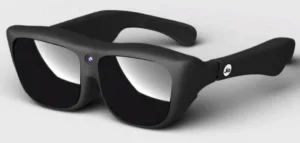In 2019, Tesseract Imaging Limited developed a mixed reality glasses type headset called the Jio HoloBoard. The company’s latest offering is called JioGlass and can be seen as a follow up to that product.

On the chance that the company Tesseract Imaging may not be familiar to readers of Display Daily, here are a few words of introduction. Tesseract is a five year old tech startup that was acquired by Reliance Industries Limited in 2019. (Reliance is an “oil-to-telecom conglomerate and India’s most valuable company.”) Tesseract develops technology for augmented reality and virtual reality oriented products such as cameras, headsets and smart glasses. Up to now, the products have been primarily targeted for use by companies. Tesseract also provides a platform for developers to build apps and content. The company consists of a team of 55 employees and is based in the Reliance Corporate Park located in Navi Mumbai.
The JioGlass headset debuted at Reliance Industries Limited 43rd Annual General Meeting. It is represented as a first-of-its-kind native product. A video introducing the headset and its’ capabilities can be found at the end of this article. The headset is pictured in the figure below.
The JioGlass mixed reality glasses type headset.
Beyond the fact that the headset is a type of virtual reality eye wear that allows people to connect with each other in real time, not much is known about the specifications of the product or its’ capabilities. It is known, though, that the JioGlass will weigh about 75 grams and will need to be connected to a smartphone. The connection is via USB-C cable which will also serve to power the headset. The headset has a built in audio system and it can make calls to contacts using voice command.
At the Annual General Meeting, Tesseract made mention of the fact that the headset will take advantage of 5G services, which Reliance is currently developing. Reliance plans to start testing its 5G services as soon as spectrum sales conclude. Also at the Annual General Meeting, the company provided a demo to how the JioGlass will work when it is made available to the public.
Tesseract has stated that the new JioGlass is primarily designed for use by teachers and students to enable 3D virtual rooms and conduct classes in real time via the Jio Mixed Reality service. In addition to this, the headset can also be used to perform virtual meetings. The company has said that the headset will ship with 25 built in apps to allow augmented reality video meetings and more.
It has been reported that Tesseract has partnered with Google on the development of JioGlass headset products. In looking at potential product developments, it can be noted that the company has filed at least five patent applications. The content of these patent applications indicate the technological focus of the company and potential capabilities and features of next generation products. A quick summary of these applications are as follows:
Relating to augmented reality:
- Optical design: curved off axis parabolic optics.
- Scene understanding: algorithms for tracking, headset localization in 3D and environment understanding.
Relating to virtual reality:
- Optical design: a novel arrangement of dual wide field of view lenses to cover and record 360 degree virtual reality photographs and videos.
- Hardware design: reference design for high throughput cameras to record and transmit 4K video data.
- 360 degree virtual reality editing: GPU optimized algorithms for stitching, transformation, object tracking and re-framing.
While the company has not disclosed the price of the JioGlass headset, one on-line commentator pointed out that e-commerce platforms show similar digital glasses with access to apps and the Internet in the price range of $500 to $540. The company has not yet revealed details of product availability. -Arthur Berman

